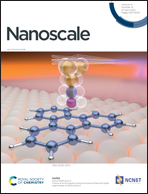Excellent response to near ultraviolet light and large intervalley scatterings of electrons in 2D SnS2†
Abstract
Tin disulfide (SnS2) has attracted much attention as a novel two dimensional material due to its potential applications in electronics and optoelectronics. In this work, we investigated the optical properties of ultra-thin SnS2 film samples (∼8 nm) via spectroscopic ellipsometry, and found that SnS2 maintains a relatively high imaginary part of the dielectric constant (ε2) in the range of 256–377 nm indicating high optical response. The carrier transport properties of SnS2 were investigated considering full mode-resolved electron–phonon couplings, which reveal that the intervalley scatterings between degenerate valley (peaks) states via the fifth optical branch phonons play a dominant role in electron scattering, while ZA phonons dominate the hole scattering. The calculated electron mobility is ∼50 cm2 V−1 s−1 which is close to previously reported experimental results. By considering full el–ph interactions based on the rigid-band approximation, the maximum value of the thermoelectric figure of merit zT reaches 0.43 at 700 K. Our work not only reveals the promising applications of SnS2 in the fields of electronics and optoelectronics, but also showcases the computational framework for precise calculations of thermoelectric performances.



 Please wait while we load your content...
Please wait while we load your content...